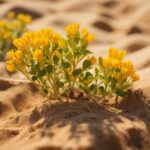The Little Redhead Spigelia is a gem in the world of perennials. With its vibrant red tubular flowers and lush green leaves, it’s no wonder gardeners are eager to learn how to care for Little Redhead Spigelia. Whether you’re a seasoned gardener or just starting out, this guide will provide all the information you need to ensure your Spigelia thrives.
Key Insights:
- Origin: Native to North America, primarily in the Eastern United States.
- Sunlight Needs: Prefers full sun to part shade.
- Soil Requirements: Well-drained soil is essential.
- Watering: Requires consistent watering, but avoid standing water.
- Attractants: A favorite among hummingbirds.
Understanding the Little Redhead Spigelia
Origin and Natural Habitat
The Little Redhead Spigelia is a proud native of North America. It’s commonly found flourishing in the woodlands and along streambanks of the Eastern United States. This perennial has been a favorite among wildflower enthusiasts, and its popularity is only growing. 1
Physical Characteristics
At the heart of its appeal are the dark red tubular flowers with striking yellow interiors. These blooms stand proudly above a clump of dark green, wedge-shaped leaves. The contrast between the fiery red flowers and the cool green foliage is truly a sight to behold. 2
Ideal Growing Conditions
Sunlight Requirements
For the Little Redhead Spigelia to truly shine, it needs the right amount of sunlight. While it can tolerate a range of light conditions, it thrives best in:
- Full Sun: More than 6 hours of direct sunlight.
- Part Shade: Between 4-6 hours of direct sunlight.
The Spigelia displays its best flowers in full sun, making it a centerpiece in any garden. 3
Soil and Watering Needs
The soil you plant your Spigelia in can make all the difference. Here’s what you need to know:
- Soil Type: Opt for well-drained soil. This ensures that the roots don’t sit in water, preventing rot.
- Watering: While the Spigelia loves water, avoiding areas with standing water is crucial. Aim for consistent watering, especially during dry spells.
Remember, a balance between hydration and drainage is the key to a happy Spigelia. 4
Benefits and Uses
Attracting Wildlife
One of the joys of planting the Little Redhead Spigelia is the wildlife it attracts. Hummingbirds, in particular, are drawn to its vibrant red flowers. This perennial is a must-have if you’ve ever wanted to create a hummingbird-friendly garden. 5
Garden Styles
The versatility of the Spigelia means it fits into various garden styles:
- Patio Container: Perfect for those with limited space.
- Cottage Garden: Adds a touch of wild beauty.
- Eclectic and Modern Gardens: A pop of color and texture.
- Woodland Shade Gardens: Blends seamlessly with other shade-loving plants.
Whether you have a sprawling garden or a cozy balcony, the Little Redhead Spigelia can find a home. 6
Fertilizing and Maintenance
The Little Redhead Spigelia is a relatively low-maintenance plant, but it benefits from the right care like all plants. Here’s how to ensure it thrives:
Fertilizing Needs
While the Spigelia isn’t particularly demanding regarding fertilization, providing it with a balanced, slow-release fertilizer in the spring can boost it. This will ensure it has all the nutrients it needs for a season of vibrant growth. 1
Seasonal Maintenance
Come fall, after the first frost turns its leaves brown, cutting the Spigelia back to the ground is a good idea. This not only helps the plant conserve energy during the winter but also ensures a fresh start come spring. 2
FAQs
Q: How much sunlight does the Little Redhead Spigelia need?
A: It thrives best in full sun to part shade. In full sun, it displays its most vibrant flowers. 3
Q: What type of soil is best for the Little Redhead Spigelia?
A: Opt for well-drained soil. This plant particularly loves moist, organically rich soils but ensures good drainage to prevent root rot. 4
Q: How often should I water the Little Redhead Spigelia?
A: It requires consistent watering, especially during dry spells. However, avoid areas with standing water to prevent overwatering. 5
Q: Is the Little Redhead Spigelia a native plant?
A: Yes, it’s native to North America and is commonly found in the Eastern United States. 6
Q: How can I attract hummingbirds to my garden with the Little Redhead Spigelia?
A: Plant it in a spot with the right conditions, and its vibrant red flowers will naturally draw hummingbirds in. 7
Conclusion
The Little Redhead Spigelia is a testament to the beauty and resilience of native North American plants. With its striking flowers and lush foliage, it’s a standout in any garden. Understanding its needs and providing the right care ensures that your Spigelia survives and thrives. Whether you’re a seasoned gardener or a newbie, the joy of watching this plant bloom is unparalleled. So, why wait? Dive into the gardening world and let the Little Redhead Spigelia be your star.
Sources/For Additional Information:
- Proven Winners® Perennials ↩
- Great Garden Plants – ‘Little Redhead’ Spigelia ↩
- Rare Roots – Spigelia marilandica ‘Little Redhead’ ↩
- Walters Gardens – Spigelia marilandica ‘Little Redhead’ ↩
- Birds and Blooms – Attracting Hummingbirds ↩
- Garden Design – Garden Styles ↩


